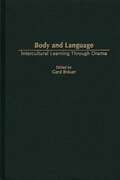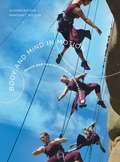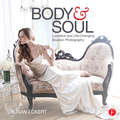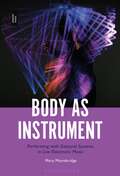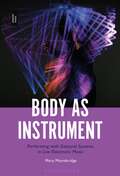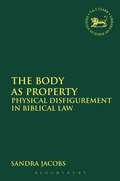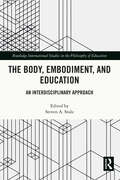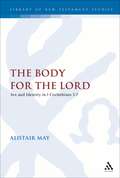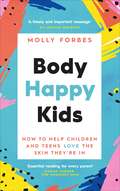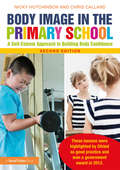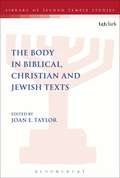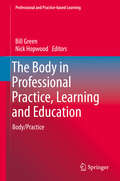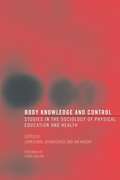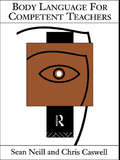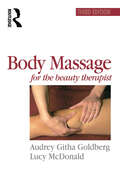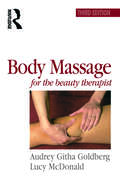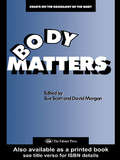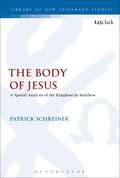- Table View
- List View
Body and Force in Music: Metaphoric Constructions in Music Psychology (SEMPRE Studies in The Psychology of Music)
by Youn KimOur understanding of music is inherently metaphorical, and metaphoricity pervades all sorts of musical discourses, be they theoretical, analytical, philosophical, pedagogical, or even scientific. The notions of "body" and "force" are the two most pervasive and comprehensive scientific metaphors in musical discourse. Throughout various intertwined contexts in history, the body–force pair manifests multiple layers of ideological frameworks and permits the conceptualization of music in a variety of ways. Youn Kim investigates these concepts of body and force in the emerging field of music psychology in the late nineteenth and early twentieth centuries. The field’s discursive space spans diverse contexts, including psychological theories of auditory perception and cognition, pedagogical theories on the performer’s bodily mechanism, speculative and practical theories of musical rhythm, and aesthetical discussion of the power of music. This investigation of body and force aims to illuminate not just the past scene of music psychology but also the notions of music that are being constructed at present.
Body and Language: Intercultural Learning Through Drama (Advances in Foreign and Second Language Pedagogy)
by Gerd BräuerHighlights the bridging character of drama-based foreign and second language teaching for intercultural learning. Drama here is not limited to theater-related work, but means the interplay between body and language in general, to include, for example, sports, dancing, singing, and storytelling. The major techniques and curricular structures of educational drama and its application in the foreign and second language classroom are introduced.What are the techniques, methods, strategies, and curricular structures that engage language learners in continuing dialogue between one's own culture and the one yet to be discovered? What comprises the language we speak in order to understand and be understood? Which body is it we communicate through and to? This volume answers these and other questions of the pedagogy of drama-based teaching across the foreign/second language curriculum and on all levels of the educational pyramid.There are two major issues currently discussed in drama-based foreign and second language methodology. The first is goal-oriented, asking whether the acquisition of accuracy or fluency is more important, and whether a controlled (learning through imitation) or an open (through improvisation) learning environment is more efficient. The second issue concerns using drama in language teaching: either its use is process-oriented, where drama becomes an immediate medium for language learning, or product-oriented, where it becomes primarily the reason for language learning. The book outlines the theoretical frameworks of both issues and introduces personal narrative, comparative observation, and analytical reflection, illuminating opportunities for learning at both ends of the seemingly contradictory poles of both issues.
Body and Mind in Motion: Dance and Neuroscience in Conversation (PDF)
by Glenna Batson Margaret WilsonDrawing from the burgeoning field of 'embodiment' – itself an idea at the intersection of the sciences, humanities, arts and technologies – Body and Mind in Motion highlights the relevance of somatic education within dance education, dance science and body-mind studies.
Body and Soul: Lucrative and Life-Changing Boudoir Photography
by Susan EckertBody and Soul presents a unique and emotionally intelligent approach to building a sustainable boudoir photography business. The higher-level strategies within these pages will enable photographers to move beyond the task of simply making pretty pictures to greater goals, such as understanding the emotional journey of the boudoir process, building meaningful, long-term relationships with clients, and creating a referral engine to sustain your business. Susan Eckert combines her professional experience as an internationally published photographer with her advanced degree in Psychology to deconstruct the boudoir experience. Each chapter is complemented by interviews with her clients, and illustrates how photographers can partner with their clients throughout the boudoir process in the development of meaningful work. Highlights of this book include: Self-assessment questionnaires to help you develop your brand and identify your market Best practices for developing positive client relationships before, during, and after the photoshoot Helpful advice for how to work with the sensitive aspects of boudoir photography, such as body image Succinct and thorough guidance for behind-the-camera techniques that will bring your client’s emotional story to life Personal interviews with clients who openly discuss their photoshoot goals, comfort levels, and boudoir photography journeys An interview with a clinical psychologist on the role and value of the emotionally-intelligent boudoir photographer
Body and Soul: Lucrative and Life-Changing Boudoir Photography
by Susan EckertBody and Soul presents a unique and emotionally intelligent approach to building a sustainable boudoir photography business. The higher-level strategies within these pages will enable photographers to move beyond the task of simply making pretty pictures to greater goals, such as understanding the emotional journey of the boudoir process, building meaningful, long-term relationships with clients, and creating a referral engine to sustain your business. Susan Eckert combines her professional experience as an internationally published photographer with her advanced degree in Psychology to deconstruct the boudoir experience. Each chapter is complemented by interviews with her clients, and illustrates how photographers can partner with their clients throughout the boudoir process in the development of meaningful work. Highlights of this book include: Self-assessment questionnaires to help you develop your brand and identify your market Best practices for developing positive client relationships before, during, and after the photoshoot Helpful advice for how to work with the sensitive aspects of boudoir photography, such as body image Succinct and thorough guidance for behind-the-camera techniques that will bring your client’s emotional story to life Personal interviews with clients who openly discuss their photoshoot goals, comfort levels, and boudoir photography journeys An interview with a clinical psychologist on the role and value of the emotionally-intelligent boudoir photographer
Body as Instrument: Performing with Gestural Systems in Live Electronic Music
by Mary MainsbridgeBody as Instrument explores how musicians interact with movement-controlled performance systems, producing sounds imbued with their individual physical signature. Using motion tracking technology, performers can translate physical actions into sonic processes, creating or adapting novel gestural systems that transcend the structures and constraints of conventional musical instruments. Interviews with influential artists in the field, Laetitia Sonami, Atau Tanaka, Pamela Z, Julie Wilson-Bokowiec, Lauren Sarah Hayes, Mark Coniglio, Garth Paine and The Bent Leather Band expose the transformational impact of motion sensors on musicians' body awareness and abilities. Coupled with reflection on author-composed works, the book analyses how the body as instrument metaphor informs relationships between performers, their bodies and self-designed instruments. It also examines the role of experiential design strategies in developing robust and nuanced gestural systems that mirror a performer's movement habits, preferences and skills, inspiring new physical forms of musical communication and diverse musical repertoire.
Body as Instrument: Performing with Gestural Systems in Live Electronic Music
by Mary MainsbridgeBody as Instrument explores how musicians interact with movement-controlled performance systems, producing sounds imbued with their individual physical signature. Using motion tracking technology, performers can translate physical actions into sonic processes, creating or adapting novel gestural systems that transcend the structures and constraints of conventional musical instruments. Interviews with influential artists in the field, Laetitia Sonami, Atau Tanaka, Pamela Z, Julie Wilson-Bokowiec, Lauren Sarah Hayes, Mark Coniglio, Garth Paine and The Bent Leather Band expose the transformational impact of motion sensors on musicians' body awareness and abilities. Coupled with reflection on author-composed works, the book analyses how the body as instrument metaphor informs relationships between performers, their bodies and self-designed instruments. It also examines the role of experiential design strategies in developing robust and nuanced gestural systems that mirror a performer's movement habits, preferences and skills, inspiring new physical forms of musical communication and diverse musical repertoire.
The Body as Property: Physical Disfigurement in Biblical Law (The Library of Hebrew Bible/Old Testament Studies #582)
by Sandra JacobsThe Body As Property indicates that physical disfigurement functioned in biblical law to verify legal property acquisition, when changes in the status of dependents were formalized. It is based on the reality the cuneiform script, in particular, was developed in Sumer and Mesopotamia for the purpose of record keeping: to provide legal proof of ownership where the inscription of a tablet evidenced the sale, or transfer, of property. Legitimate property acquisition was as important in biblical law, where physical disfigurements marked dependents, in a similar way that the veil or the head covering identified a wife or concubine in ancient Assyrian and Judean societies. This is primarily substantiated in the accounts of prescriptive disfigurements: namely circumcision and the piercing of a slave's ear, both of which were required only when a son, or slave, was acquired permanently. It is further argued that legal entitlement was relevant also to the punitive disfigurements recorded in Exodus 21:22-24, and Deuteronomy 25:11-12, where the physical violation of women was of concern solely as an infringement of male property rights.
The Body, Embodiment, and Education: An Interdisciplinary Approach (Routledge International Studies in the Philosophy of Education)
by Steven A. StolzNotions of the body and embodiment have become prominent across a number of established discipline areas, like philosophy, sociology, and psychology. While there has been a paradigmatic shift towards this topic, there is a notable gap in the literature as it relates to education and educational research. The Body, Embodiment and Education addresses the gap between embodiment and education by exploring conceptualisations of the body and embodiment from interdisciplinary perspectives. With contributions from international experts in philosophy, sociology, and psychology, as well as emerging areas in related fields, such as embodied cognition, neuroscience, cognitive science, this book sets a new research agenda in education and educational research. Each chapter makes a case for expanding the field and adds to the call for further exploration. The Body, Embodiment and Education will be of great interest to academics, researchers and postgraduate students who are interested in the body and embodiment and/or its relationship with education or educational research.
The Body, Embodiment, and Education: An Interdisciplinary Approach (Routledge International Studies in the Philosophy of Education)
by Steven A. StolzNotions of the body and embodiment have become prominent across a number of established discipline areas, like philosophy, sociology, and psychology. While there has been a paradigmatic shift towards this topic, there is a notable gap in the literature as it relates to education and educational research. The Body, Embodiment and Education addresses the gap between embodiment and education by exploring conceptualisations of the body and embodiment from interdisciplinary perspectives. With contributions from international experts in philosophy, sociology, and psychology, as well as emerging areas in related fields, such as embodied cognition, neuroscience, cognitive science, this book sets a new research agenda in education and educational research. Each chapter makes a case for expanding the field and adds to the call for further exploration. The Body, Embodiment and Education will be of great interest to academics, researchers and postgraduate students who are interested in the body and embodiment and/or its relationship with education or educational research.
The Body for the Lord: Sex and Identity in 1 Corinthians 5-7 (The Library of New Testament Studies #278)
by Alistair MayAlistair May explores the part played by sexual ethics and the rhetoric of sexual morality in the formation of Christian identity by focusing on the longest discussion of sex in the New Testament - 1Corinthians 5-7. Viewing this passage as a unified discourse, he considers how Paul's ethics serve to give his converts a distinct identity. Although tools from the social sciences are used, the major focus of the work is in careful exegesis of the text. As the study progresses through the text of 1Corinthians 5-7, May argues that Paul strives to maintain an absolute distinction between insider and outsider in regard to morality. Immorality belongs exclusively to the outside and to the pre-conversion identity of the Corinthians. Hence those labelled immoral can no longer remain in the community. 1 Corinthians 6.12-20 reveals that, for Paul, sexual sin is unique in its destruction of Christian identity and that any sexual participation is a potential conflict with participation in Christ. Thus, chapter 6 is directly connected with the discussion of the legitimacy of marriage in 1Corinthians 7. Rejecting the scholarly consensus that Paul is reacting to ascetics, May controversially argues that chapter 7 should be read as Paul's commendation of singleness to a reluctant Corinthian audience.This is volume 278 in the Journal for the Study of the New Testament Supplement series.
Body Happy Kids: How to help children and teens love the skin they’re in
by Molly ForbesWe are not born hating our bodies. Make sure your kids never do.No parent wants their child to grow up with anything less than wholehearted confidence in themselves. Sadly research shows that children as young as five are saying they need to 'go on a diet' and over half of 11 to 16-year-olds regularly worry about the way they look. Campaigner and mum-of-two-girls Molly Forbes is here to help.In Body Happy Kids, Molly draws on her own experience and a range of experts to provide parents with a much-needed antidote to the confusing health advice that bombards us every day. This reassuring and practical guide covers everything you need to help your child to care for their body with kindness, including how to approach good nutrition (without falling for diet culture), how to see the reality behind beauty ideals and how social media can be used to support body confidence rather than destroy it. With Molly's help, you can arm yourself with the insight and tools to raise resilient children who love the skin they're in.
Body Image in the Primary School: A Self-Esteem Approach to Building Body Confidence
by Nicky Hutchinson Chris Calland80% of primary aged children have been on a diet. 75% of 10- to 11-year-olds would like to change their appearance. Children as young as 6 are worrying about their shape and size. Body image is an important aspect of children’s self-esteem and confidence. Unfortunately, many young children are suffering from anxieties about their appearance, which has a harmful effect on their overall mental health and wellbeing. This updated second edition of the award-winning Body Image in the Primary School recognises these anxieties as a concern for younger children that needs to be addressed at an early age, and examines some of the pressures that young people face. Presenting a clear, easy-to-use scheme of work to support emotional literacy and Personal, Social, Health and Economic Education (PSHE), throughout the primary school and into the first years of secondary school, this new edition offers: A practical evidence based curriculum for children aged 4 –13. More than 60 lively, varied and detailed lesson plans. Additional lessons on gender, social media and the selfie culture. An overview of research on the links between body image, academic achievement and emotional wellbeing. The evidence-based lessons in Body Image in the Primary School have been awarded the quality kitemark by the PSHE Association and highlighted by Ofsted as an example of excellent practice. This book will be of significant interest to all teachers, teaching assistants and practitioners working with primary aged children.
Body Image in the Primary School: A Self-Esteem Approach to Building Body Confidence
by Nicky Hutchinson Chris Calland80% of primary aged children have been on a diet. 75% of 10- to 11-year-olds would like to change their appearance. Children as young as 6 are worrying about their shape and size. Body image is an important aspect of children’s self-esteem and confidence. Unfortunately, many young children are suffering from anxieties about their appearance, which has a harmful effect on their overall mental health and wellbeing. This updated second edition of the award-winning Body Image in the Primary School recognises these anxieties as a concern for younger children that needs to be addressed at an early age, and examines some of the pressures that young people face. Presenting a clear, easy-to-use scheme of work to support emotional literacy and Personal, Social, Health and Economic Education (PSHE), throughout the primary school and into the first years of secondary school, this new edition offers: A practical evidence based curriculum for children aged 4 –13. More than 60 lively, varied and detailed lesson plans. Additional lessons on gender, social media and the selfie culture. An overview of research on the links between body image, academic achievement and emotional wellbeing. The evidence-based lessons in Body Image in the Primary School have been awarded the quality kitemark by the PSHE Association and highlighted by Ofsted as an example of excellent practice. This book will be of significant interest to all teachers, teaching assistants and practitioners working with primary aged children.
The Body in Biblical, Christian and Jewish Texts (The Library of Second Temple Studies #85)
by Joan E. TaylorThe body is an entity on which religious ideology is printed. Thus it is frequently a subject of interest, anxiety, prescription and regulation in both the Hebrew Bible and the New Testament, as well as in early Christian and Jewish writings. Issues such as the body's age, purity, sickness, ability, gender, sexual actions, marking, clothing, modesty or placement can revolve around what the body is and is not supposed to be or do. The Body in Biblical, Christian and Jewish Texts comprises a range of inter-disciplinary and creative explorations of the body as it is described and defined in religious literature, with chapters largely written by new scholars with fresh perspectives. This is a subject with wide and important repercussions in diverse cultural contexts today.
The Body in Professional Practice, Learning and Education: Body/Practice (Professional and Practice-based Learning #11)
by Bill Green Nick HopwoodThe body matters, in practice. How then might we think about the body in our work in and on professional practice, learning and education? What value is there in realising and articulating the notion of the professional practitioner as crucially embodied? Beyond that, what of conceiving of the professional practice field itself as a living corporate body? How is the body implicated in understanding and researching professional practice, learning and education? Body/Practice is an extensive volume dedicated to exploring these and related questions, philosophically and empirically. It constitutes a rare but much needed reframing of scholarship relating to professional practice and its relation with professional learning and professional education more generally. It takes bodies seriously, developing theoretical frameworks, offering detailed analyses from empirical studies, and opening up questions of representation.The book is organized into four parts: I. ‘Introducing the Body in Professional Practice, Learning and Education’; II. ‘Thinking with the Body in Professional Practice’; III. ‘The Body in Question in Health Professional Education and Practice’; IV. ‘Concluding Reflections’. It brings together researchers from a range of disciplinary and professional practice fields, including particular reference to Health and Education. Across fifteen chapters, the authors explore a broad range of issues and challenges with regard to corporeality, practice theory and philosophy, and professional education, providing an innovative, coherent and richly informed account of what it means to bring the body back in, with regard to professional education and beyond.
Body Knowledge And Control: Studies In The Sociology Of Physical Education And Health (PDF)
by John Evans Brian Davies Jan Wright Chris ShillingToday's society is obsessed with the body, its size, shape and healthiness. Governments, business and the popular media, spend and earn fortunes encouraging populations to get healthy, eat properly, exercise daily and get thin. But how are current social trends and attitudes towards the body reflected in the curriculum of schools, in the teaching of Physical Education and Health? How do teachers and health professionals influence young people's experiences of their own and others' bodies? Is health education liberating or merely another form of regulation and social control? Drawing together some of the latest research on the body and schooling, Body Knowledge and Control offers a sharp and challenging critique of (post) modern-day attitudes toward obesity, health, childhood and the mainstream science and business interests that promote narrow body-centred ways of thinking. Includes: * A critical history of notions of body, identity and health in schools. * Analysis of the 'obesity epidemic', eating disorders* Analysis of the influence of nurtured body image in racism, sexism, homophobia and body elitism in schools.
Body Language for Competent Teachers
by Chris Caswell Sean NeillNon-verbal skills are invaluable for teachers in getting their own messages across to classes and understanding the messages pupils are sending them. Here an educational psychologist and a classroom teacher join forces to show new teachers in particular how to use gesture, posture, facial expression and tone of voice effectively to establish a good relationship with the classes that they teach. Each chapter is illustrated with clear drawings of pupils and teachers in common classroom situations and accompanied by training exercises aimed at improving the new teacher's ability to observe both her class and her own practice. A section at the end of the book gives suggested solutions to some of the exercises and the final chapter, addressed to staff responsible for their colleagues' professional development, provides suggestions for half and whole day courses.
Body Language for Competent Teachers
by Chris Caswell Sean NeillNon-verbal skills are invaluable for teachers in getting their own messages across to classes and understanding the messages pupils are sending them. Here an educational psychologist and a classroom teacher join forces to show new teachers in particular how to use gesture, posture, facial expression and tone of voice effectively to establish a good relationship with the classes that they teach. Each chapter is illustrated with clear drawings of pupils and teachers in common classroom situations and accompanied by training exercises aimed at improving the new teacher's ability to observe both her class and her own practice. A section at the end of the book gives suggested solutions to some of the exercises and the final chapter, addressed to staff responsible for their colleagues' professional development, provides suggestions for half and whole day courses.
Body Massage for the Beauty Therapist
by Audrey Goldberg Lucy McdonaldThe beauty therapist, increasingly called upon to administer massage, will welcome this manual. Its modern and practical approach will appeal to all who wish to improve their standard of massage. The physical comfort and reassurance which massage can give, especially when coupled with exercises, make it more than a sensuous luxury: rather it is a positive factor in promoting bodily wellbeing. The clear and detailed explanations of massage techniques in 'Body Massage for the Beauty Therapist' are supplemented by many drawings and photographs, which also serve to clarify the structure of the human body and its functioning. The personality and qualities of the therapist are brought into perspective and helpful advice given on the organization of the salon. Valuable sections are included on relaxation techniques, correct breathing and exercises which the client can undertake. Aromatherapy and gyratory massage are also covered.
Body Massage for the Beauty Therapist
by Audrey Goldberg Lucy McdonaldThe beauty therapist, increasingly called upon to administer massage, will welcome this manual. Its modern and practical approach will appeal to all who wish to improve their standard of massage. The physical comfort and reassurance which massage can give, especially when coupled with exercises, make it more than a sensuous luxury: rather it is a positive factor in promoting bodily wellbeing. The clear and detailed explanations of massage techniques in 'Body Massage for the Beauty Therapist' are supplemented by many drawings and photographs, which also serve to clarify the structure of the human body and its functioning. The personality and qualities of the therapist are brought into perspective and helpful advice given on the organization of the salon. Valuable sections are included on relaxation techniques, correct breathing and exercises which the client can undertake. Aromatherapy and gyratory massage are also covered.
Body Matters: Essays On The Sociology Of The Body
by Sue Scott David MorganFocusing on the sociological embodiment of various "social actors", the authors consider the subsequent links with the constraints of daily life i.e. the male body, female therapists, body builders, marital and sexual counsellors, sex workers. They present recent or new research findings on aspects of the body, variants from what is conventionally seen as "natural" and consider and question aspects of self-image versus society's expectations. A number of developments in discussions of the body on such topics as feminist thought, the study of health and illness and cultural theory are presented as a series of essays which demonstrate the variety of interests mentioned.; The book is aimed at undergraduates/postgraduates students and lecturers in sociology, cultural studies, women's and gender studies.
Body Matters: Essays On The Sociology Of The Body
by Sue Scott David MorganFocusing on the sociological embodiment of various "social actors", the authors consider the subsequent links with the constraints of daily life i.e. the male body, female therapists, body builders, marital and sexual counsellors, sex workers. They present recent or new research findings on aspects of the body, variants from what is conventionally seen as "natural" and consider and question aspects of self-image versus society's expectations. A number of developments in discussions of the body on such topics as feminist thought, the study of health and illness and cultural theory are presented as a series of essays which demonstrate the variety of interests mentioned.; The book is aimed at undergraduates/postgraduates students and lecturers in sociology, cultural studies, women's and gender studies.
The Body of Jesus: A Spatial Analysis of the Kingdom in Matthew (The Library of New Testament Studies #555)
by Patrick SchreinerLittle attention is usually given to the space or place of the kingdom. Yet Matthew employs the distinctive phrase "kingdom of heaven†? and also portrays Jesus as Immanuel (God with us). In this volume Patrick Schreiner argues that by expanding one's view of space one can see that Jesus' purpose is to reorder the space of the earth in Matthew as the heavenly king. Jesus pierces the barrier between the two realms in his incarnation, and the spaces of heaven and earth begin to collide in his ministry. Therefore, in Matthew, Jesus does not just promise a temporal or ethereal kingdom, but one that is located, one that has a sense of rootedness. Jesus is granted authority over this space and inspires people to follow him in this construction project. The spatial kingdom begins in his body, and he extends it to his church by promising his presence.
The Body of Jesus: A Spatial Analysis of the Kingdom in Matthew (The Library of New Testament Studies)
by Patrick SchreinerLittle attention is usually given to the space or place of the kingdom. Yet Matthew employs the distinctive phrase “kingdom of heaven” and also portrays Jesus as Immanuel (God with us). In this volume Patrick Schreiner argues that by expanding one's view of space one can see that Jesus' purpose is to reorder the space of the earth in Matthew as the heavenly king. Jesus pierces the barrier between the two realms in his incarnation, and the spaces of heaven and earth begin to collide in his ministry. Therefore, in Matthew, Jesus does not just promise a temporal or ethereal kingdom, but one that is located, one that has a sense of rootedness. Jesus is granted authority over this space and inspires people to follow him in this construction project. The spatial kingdom begins in his body, and he extends it to his church by promising his presence.

